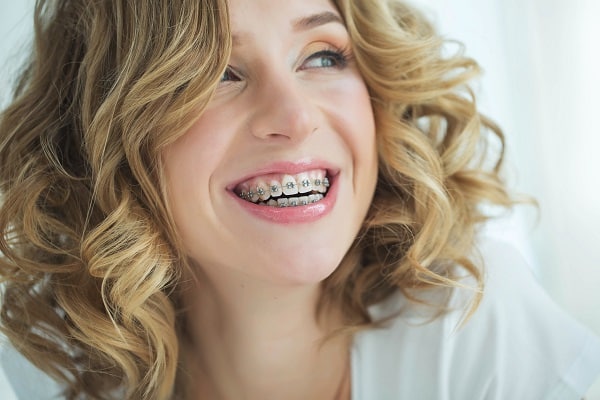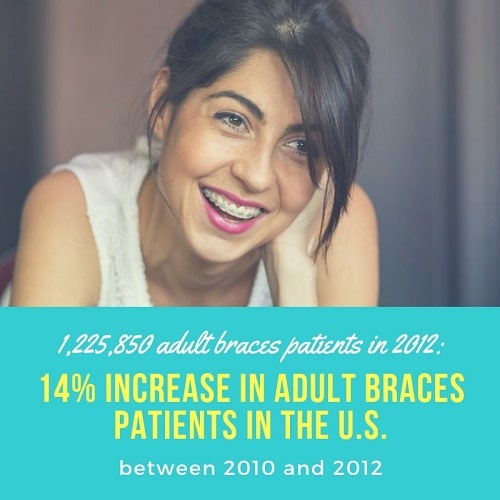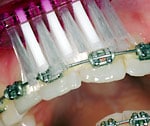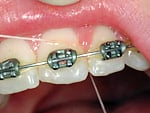Orthodontists Serving Denver, Cherry Creek, Stapleton & Nearby Areas Of Colorado
Malocclusion – or the misalignment of the teeth when the jaws come together – is corrected with braces. Braces have been used for generations to create smiles that are both healthy and aesthetically pleasing. Modern braces are common among children and adults alike, and there are various types from which to choose. To find out which braces you are a candidate for, please call Advanced Orthodontic Care in Denver at 303-331-0222.
Dr. Robert Rudman and Dr. Jeff Birg are an experienced orthodontists who founded our practice in 1999. He is personally driven by achieving great results for his patients. Please browse the sections below to learn more.
Are Braces Right for You?
Braces address various types of malocclusion:
- Crooked teeth
- Crowded teeth
- Gaps between teeth
- Open bite
- Cross bite
- Over bite
- Under bite

Malocclusion is very common. Even if your teeth look mostly straight, the way the jaws come together may be unbalanced or not fully aligned, which can lead to issues with the comfort of your bite. Your "bite" is in fact the way your teeth and jaws come together when you bite down. A bad bite can increase your risk of several problems:
- Jaw soreness
- Straining of the muscles, ligaments and nerves associated with the jaws and face
- Abnormal or uneven wearing of your teeth enamel
- Discomfort while chewing
- Difficulties with speech
- Tooth decay
- Gum disease
- Tooth loss
Braces not only create beautiful smiles, they also address the functional and health-related issues above.
Dr. Rudman and Dr. Birg will use x-rays, photos, and an exam to assess your bite and the straightness of your teeth. If he determines you can benefit from braces, he will explain all of the types of braces that will work for you. Everyone's malocclusion is different, and the teeth must move in specific ways in order to create alignment. Dr. Rudman and Dr. Birg determine which types of braces are capable of moving the teeth in the right way for the individual patient.

Types of Braces
In this day and age, there is more than one option when it comes to braces:
- Traditional metal braces. These are the braces that may come to mind first. Metal brackets and wires gradually move the teeth over time, until the desired alignment is achieved. Rubber bands are used in various configurations to exert force on the brackets. Braces are much lower profile than in the past. You can choose colorful, clear or tooth-colored rubber bands to personalize your braces.
- Clear or "ceramic" braces. These braces work the same way as the metal kind, but the brackets are clear. They blend into the color of your teeth and offer a less visible option. The wires are metal and you can choose clear, tooth-colored or colorful rubber bands.
- Invisalign®. Just like braces, Invisalign works by putting pressure on the tooth. Unlike braces, there are no brackets or wires. Instead, you wear custom-made plastic aligners over your teeth, similar to a mouth guard. Each aligner is shaped in a specific way to get the teeth to move according to plan. You remove Invisalign to eat and to brush, and most people won't know you are wearing them.
- Synergy R. This new bracket system is self-ligating, meaning there is no need for the o-shaped rubber bands to hold the wire to the bracket that are a mainstay of traditional braces. Though there are many types of self-ligating brackets, Synergy R’s benefits are that they offer more comfortable tooth movement, use lighter force, have lower friction, and it takes less time to have them adjusted.
- Incognito®. These braces use metal brackets and wires placed on the inner surface of your teeth. They aren't typically visible when you smile, although people may see them when you speak and laugh. Nonetheless, many people feel much more confident knowing their braces are positioned less visibly.
Dr. Rudman and Dr. Birg can show you examples of these choices and answer any questions you have about treatment length, comfort, results, cost, and any other questions to help you make your decision.

Braces for Adults
An increasing percentage of orthodontic patients today are adults. Whether you've never worn braces or had them previously, treatment as an adult can create the smile you want and healthy, straight teeth that will serve you well in the decades ahead.
Adult braces patients report several benefits of treatment:
- Improve your confidence at work
- Feel good about your smile in social interactions
- Pose for photos without covering your teeth or pressing your lips together
- Prevent the discomfort and strain of an unbalanced bite

Even if you had braces as a teen, your teeth may have relapsed to their former positions. Perhaps you lost your retainer at some point and your teeth are crooked again. There are many reasons adults seek braces, and Dr. Rudman and Dr. Birg can help you decide if a low-profile option like Invisalign will work, or if you want to go the traditional route. Seeing people in their 20s, 30, 40s, 50s and beyond with metal wires and brackets is not at all uncommon these days. Many see the benefit of having straight, strong and healthy teeth for the long-run.
How Braces Work
Braces move teeth over time via constant pressure on the tooth and its root. As the root moves, the bone around it grows and adapts to hold the new position.

There are four basic parts to conventional braces:
- Brackets attached to each tooth
- A bonding material that attaches the bracket to the tooth's surface
- A thin metal arch wire that runs from bracket to bracket and puts pressure on the teeth
- The ligature elastic or “o-ring,” a rubber band that joins the bracket to the arch wire
The o-ring rubber bands around each bracket are necessary to get the bracket to exert pressure. Without these bands, the bracket and wires wouldn't really accomplish much. The bands are sometimes placed in a criss-cross pattern around the bracket, or in other patterns in order to achieve the desired movement. There are other types of rubber bands used during treatment. Some are called "chains" because they are a series of o-rings in one piece. Other rubber bands stretch from the top teeth to the bottom teeth. All of these things are essential in order to get the final bite alignment Dr. Rudman and Dr. Birg has planned for you.
Dental Hygiene with Braces
Great dental hygiene is always important, including while you are wearing braces. The brackets and wires easily trap food and sugar, which means it could be sitting on your enamel for a while if you don't brush.
Without braces, poor dental hygiene leads to cavities. This can also happen with braces, with the additional risk of "white stain lesions," which are white spots caused by plaque buildup around brackets. These white stains are just about impossible to get rid of once they have formed. The vast majority of patients avoid these stains though, because they are completely preventable with brushing. You should also enjoy sodas in moderation while wearing braces, since the sugary liquid easily sticks around the margin of the brackets.
How to brush with braces:
Your brushing technique is largely the same when you have braces. You'll hold the bristles at an angle and brush above the wires and then from below the wires, so that all areas are cleaned. Use soft bristles and gentle pressure, just as you should normally.
With braces, brush at least 3 times daily to avoid the accumulation of food particles on your teeth and braces:

- In the morning after breakfast
- After lunch or right after school
- At bedtime
You will need to replace your toothbrush more often due to your appliances. As soon as the bristles start to wear down or fray, replace your toothbrush with a new one.
How to floss with braces:
For areas between the teeth that a toothbrush can’t reach, use dental floss to remove food particles and plaque. Flossing takes more time and patience when you are wearing braces, but it is important to floss your teeth every day.

Use the reusable floss threader provided by our office to floss under your archwire daily. Pull a small length of floss from the dispenser through the threader and slide it up and down along the front of each tooth. Use care around your archwire and do not floss too forcefully around it or put too much pressure on it. After you floss between your archwire and braces, floss between your other teeth and gums. Floss at night to make sure your teeth are clean before you go to bed.
When you get your braces, we'll make sure you know how to brush and floss correctly before sending you on your way. We'll also provide you with dental wax, which can be applied to any parts of your braces that are poking or rubbing your cheek or gums.
Foods to Avoid with Braces
You can eat mostly the same foods with braces, with some exceptions. Some foods will need to be cut into smaller pieces while others will need to be avoided altogether. The reason is that certain foods can bend archwires and dislodge brackets. These things require additional appointments for repairs and may lengthen your treatment time.
Common sense can be used in most cases. We'll provide you with a list of the main braces-breaking culprits. In general, hard foods and sticky foods are the ones to look out for, as well as any foods that seem like they could get stuck (popcorn).
Here are some examples of sticky or chewy foods to avoid:
- Caramels
- Candies
- Chewy bagels
- Crusty bread
- Caramel apples
- Taffy
- Sugared gum
There are also hard/tough foods you cut into very small bite-size pieces:
- Apples
- Steak
- Roast
- Carrots
These items should be avoided altogether:
- Ice cubes
- Hard taco shells
- Tortilla chips
- Corn on the cob
- Potato chips
- Chewy candy
- Chewy pizza crust
- Crunchy nuts

If something feels different, it may be a broken wire or bracket. You may feel the wire poking, or your teeth may feel sore if they are starting to move because of a loose bracket. When you notice a problem, call our office to schedule a repair appointment as soon as possible.
Patient Testimonial
What People Say About Us!
Click here to read more reviews.
Questions about Braces
How long do braces typically need to be worn?
It depends on the state of your bite, what movement needs to take place, your age, the braces chosen and other factors. Rest assured, we will give you a timeline estimate at the time of your consultation, so that you know what to expect. It could be anywhere from 6 months to several years. Most people require between 1-3 years. Patients report it's worth it when they see their straightened, pretty smile once treatment is complete.

Will my braces cause pain?
Braces cause soreness, which varies by patient. This typically occurs the first full day after your wires and rubber bands are changed, as they may be tighter and/or in a different configuration than before, and the teeth will start moving again. The vast majority of people find adequate relief in an over-the-counter pain med like ibuprofen, and the soreness should go away after a day or two.
How old do you need to be to have braces?
There is no upper age limit for braces. Your teeth and bite are important your whole life. While many adults feel hesitant to opt into treatment, once their smile is complete they are ecstatic to see their new smiles.
Can I play sports with braces?
Yes, but we encourage you to wear a mouth guard when playing any sport.
What happens after your braces are removed?
After treatment, you enter the "retention phase" of treatment. Teeth will gradually return to their former positions without retention. Dr. Rudman and Dr. Birg provides permanent retainers, which are thin, tiny wires affixed to the back of your teeth. He may also recommend a plastic tray retainer that you place over your teeth while you sleep. Using your retainer will keep your teeth straight.
How Long Do You Have to Wear Braces?
The average patient typically has to wear braces for at least 18 to 24 months. However, there are cases where a patient may need to wear them for longer periods of time. This does depend on the condition of their teeth and the severity of their dental problems.
Do I Have to Brush My Teeth More With Braces?
Although you should always keep your teeth clean at all times, you can continue to brush your teeth at least twice a day for two minutes. Since you are wearing braces, it is highly recommended that you brush your teeth after every meal. This way, you can remove any loose food that could be stuck in your braces.
Do I Still Need Dental Checkups With Braces?
Yes, you will need to have routine dental checkups to ensure the braces are working. In addition, it is also necessary to have more dental checkups when wearing braces because dentists can remove food particles that you cannot reach with regular brushing. A dentist can also make any minor adjustment to your braces should they find a problem.
Yes, you will need to have routine dental checkups to ensure the braces are working. In addition, it is also necessary to have more dental checkups when wearing braces because dentists can remove food particles that you cannot reach with regular brushing. A dentist can also make any minor adjustment to your braces should they find a problem.
Schedule Your Consultation For Braces in Denver, CO
Ready to find out if braces are right for you? To schedule a FREE consultation with experienced Denver orthodontists Dr. Robert Rudman and Dr. Birg, please call Advanced Orthodontic Care at 303-331-0222. Our braces patients visit us from across the surrounding areas, including Cherry Creek and Stapleton.


